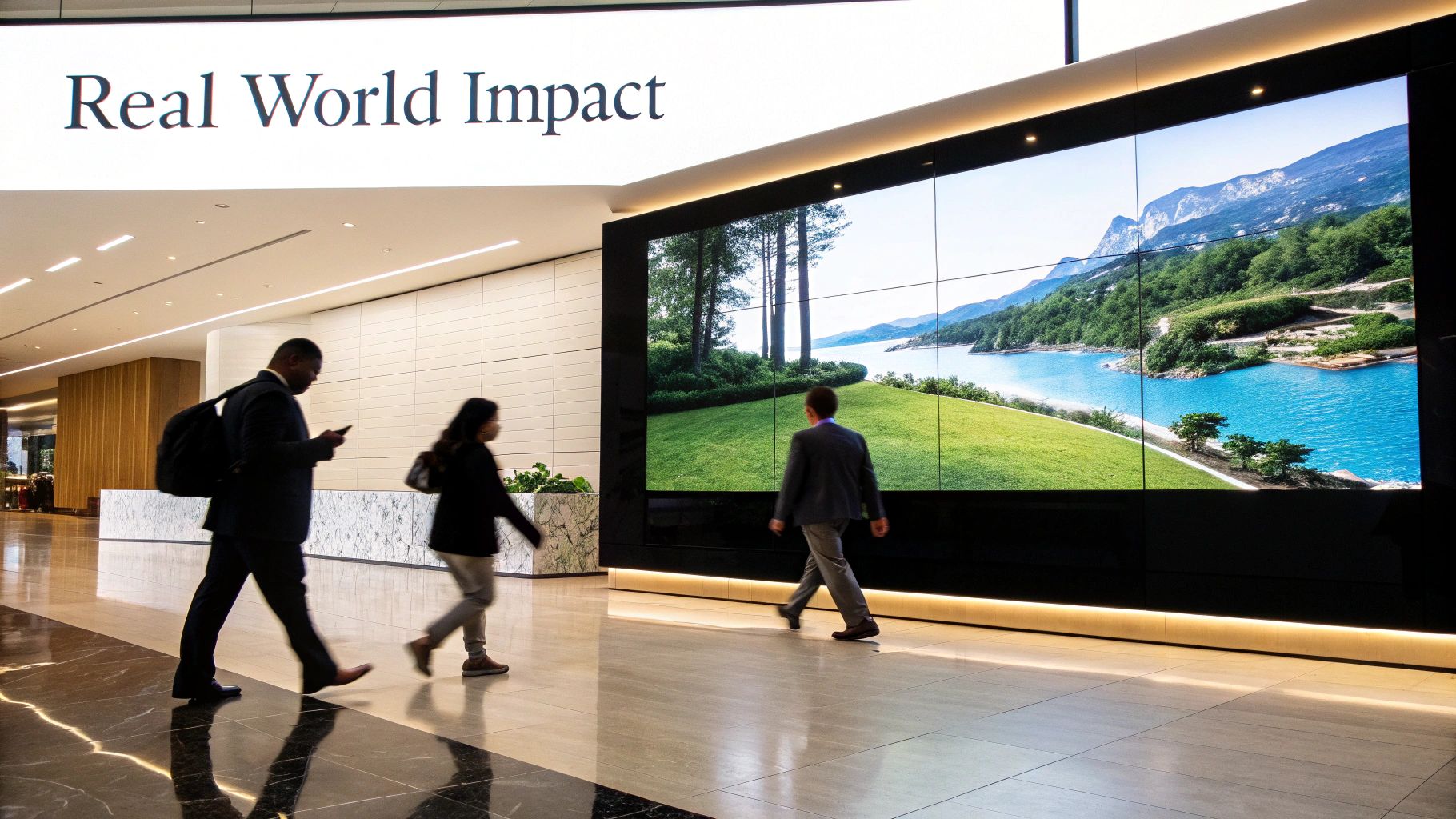
Stage with led screen: Elevate Your Event Visuals Today
Not long ago, a stage with an led screen was just a fancy backdrop. Now, it's the dynamic, beating heart of any modern live event.

Forget static paintings and traditional wallpaper. Imagine your wall transforming into a living canvas, a vibrant, ever-changing backdrop for visual storytelling. That's the power of a digital art wall—a large-scale display system designed to bring curated art, dynamic visuals, and immersive content to any space.
Think of it like this: a classic painting is a single vinyl record, beautiful but fixed. A digital art wall, on the other hand, is your personal streaming service for visual art. It gives you an entire library of experiences to match any mood, time of day, or special occasion, all at your command.
At its heart, a digital art wall isn't just a screen; it's an integrated system where three key parts work together seamlessly:
When these elements come together, the wall stops being simple decoration. It starts creating an atmosphere, turning a passive surface into an active participant in the environment. A corporate lobby can greet visitors with serene nature scenes in the morning and shift to bold, brand-focused visuals in the afternoon. At home, your living room could display a famous masterpiece for a dinner party or a cozy, crackling fireplace on a cold winter night.
A well-executed digital art wall does more than just show pictures; it shapes the emotional tone of a space. It’s a powerful tool for expression, branding, and creating truly unforgettable experiences.
This move toward dynamic visual installations isn't just a niche fad. It reflects a much bigger shift in how we design and interact with our spaces. The global wall art market is already massive, valued at around USD 59.51 billion in 2025 and on track to hit USD 77.3 billion by 2029. A huge driver of this growth is technology that speaks to a digitally native audience. If you want to dive deeper, you can read the full research about wall art innovations.
Digital art walls are leading this charge. They offer a modern alternative that feels right at home in our increasingly digital lives, providing a medium for expression that is fluid, personal, and endlessly adaptable. This is where technology and artistry meet to redefine the very idea of a wall.
To really get what makes a digital art wall tick, you have to look under the hood. It’s the combination of specific hardware and software that brings those incredible visuals to life. While it might sound complicated at first, breaking it down piece by piece makes it all click. Understanding these core parts is the first step to planning an installation that not only looks amazing but works flawlessly in your space.
This diagram gives you a bird's-eye view of how the physical display, control software, and visual content all play together.

As you can see, a great digital art wall is really an ecosystem. The screen, the brains behind it, and the art itself are all completely interconnected.
If you only learn one technical term, make it pixel pitch. Think of it as the thread count for a digital fabric. It’s simply the distance, measured in millimeters, from the center of one tiny pixel to the center of the next one. A smaller number means the pixels are packed tighter, creating a much sharper, higher-resolution image.
This "thread count" directly determines how clear the image looks from different distances. It’s a game of trade-offs.
There's a simple rule of thumb we use in the field: for every 1mm of pixel pitch, the ideal viewing distance starts at about 8 feet. So, a display with a 2.5mm pixel pitch will look perfectly crisp from around 20 feet away, while a finer 1.5mm pitch screen holds its own from as close as 12 feet. Getting this right is everything. It ensures you’re delivering a flawless visual experience without any distracting pixelation.
The goal is to match the pixel pitch to the environment. You don't need to pay for an ultra-fine pitch if your audience will always be across a large room, but for up-close engagement, that fine detail is everything.
Picking the right pixel pitch is one of the most important decisions you'll make, as it directly impacts both the visual quality and the budget of your project. This table breaks down the relationship between viewing distance and the recommended pixel pitch to help guide your choice.
| Viewing Distance | Recommended Pixel Pitch | Ideal Application |
|---|---|---|
| < 10 feet | 0.9mm – 1.5mm | Boardrooms, control rooms, luxury retail, museum exhibits |
| 10 – 20 feet | 1.5mm – 2.5mm | Corporate lobbies, reception areas, broadcast studios |
| 20 – 30 feet | 2.5mm – 4mm | Auditoriums, large conference rooms, houses of worship |
| 30+ feet | 4mm and up | Arenas, large atriums, transportation hubs, billboards |
Ultimately, the best choice depends on where your audience will be standing. Nail this, and you’re well on your way to an incredible installation.
Right after resolution, we need to talk about brightness, which is measured in nits. Just think of nits as the volume knob for light. A cozy lounge with dim, controlled lighting might only need a display that puts out around 500-800 nits. But if you're installing a wall in a sun-drenched atrium or a storefront window, you need to crank that volume way up—often to 1,500 nits or more—just to compete with the ambient light and avoid looking washed out.
The display tech itself also makes a huge difference. While you'll see LCD and OLED screens out there, modern LED (Light Emitting Diode) panels are the undisputed industry standard for professional digital art walls. Their modular design lets us build completely seamless displays of any size or shape imaginable, and they offer far superior brightness and longevity. If you want to see how these components come together in the real world, check out the specs for professional-grade SMART LED indoor LED wall panels.
Finally, how the wall is physically integrated into the space is just as critical as the tech inside it. Mounting options are incredibly versatile, from perfectly recessed installations that make the screen look like part of the building's architecture to artistic "floating" setups that turn the display into a sculpture. A key part of planning these complex integrations is using detailed interior design rendering to visualize exactly how the final piece will look and feel.
Once it's installed, professional color calibration is absolutely non-negotiable. This is the process where a technician ensures every single panel in the wall displays color in perfect uniformity. Without it, you get a distracting "patchwork quilt" effect where some panels look a little off, completely shattering the illusion. This final touch is what elevates a collection of screens into a single, breathtaking canvas of digital art.
If the physical display is your canvas, then the content is the paint, the sculpture, and the artist all rolled into one. A digital art wall is only as compelling as the visuals dancing across its surface. This makes your content strategy just as critical as the hardware itself.
This is where a Content Management System (CMS) steps in. It's the brain of the entire operation.
Think of a CMS as your personal art curator or a digital DJ for your wall. It's the software that lets you upload, organize, and schedule everything that appears on the screen. Instead of just looping a single image, a powerful CMS lets you build sophisticated playlists that can completely change the atmosphere of a space throughout the day.

You could schedule serene, slow-moving nature scenes for the morning, shift to vibrant abstract art in the afternoon, and then switch to a dramatic video piece in the evening. That level of control transforms the wall from a static object into a living, breathing part of the environment.
The real beauty of a digital art wall is its sheer versatility. You aren't just limited to static images. This medium thrives on movement, change, and even data, opening up a world of creative possibilities that a traditional canvas just can't match. The content you choose will ultimately define the impact of your installation.
Some of the most effective types of content include:
This growing appetite for dynamic visuals is fueling a massive market. Valued at USD 5.8 billion in 2025, the digital artwork market is projected to skyrocket to USD 17.72 billion by 2032. This incredible growth is driven by everything from digital paintings to NFTs, expanding the library of potential artworks available for any space.
With a world of content at your fingertips, the next step is deciding whether to source existing art or create something completely bespoke. Both paths offer unique advantages.
Sourcing Existing Art
Many platforms and digital art marketplaces offer curated libraries of high-quality content specifically designed for large-scale displays. This is often the fastest and most cost-effective way to populate your wall with stunning visuals from artists around the globe.
Curation is key. The goal isn't just to find beautiful images, but to select pieces that align with your brand's identity or your home's aesthetic. You're creating a cohesive and purposeful visual narrative.
Creating Custom Content
For a truly unique installation that perfectly captures a brand story or personal vision, nothing beats custom content. This involves commissioning digital artists, animators, or creative agencies to produce visuals tailored specifically to your display and your goals. If you're inspired to create your own unique visuals, exploring the best digital art software for beginners is a great place to start.
Ultimately, the most successful content strategies often involve a hybrid approach. You might use a library of curated art for daily ambiance while commissioning a signature, branded piece that serves as the stunning centerpiece. This balance ensures your wall remains fresh, relevant, and endlessly engaging.
This is where the magic really happens. A digital art wall isn't just about the tech specs; it’s about how it can completely transform a physical space. It's about creating an atmosphere, telling a story, and shaping an experience from the moment someone walks in. Let's look at how these dynamic canvases are making a real impact in corporate, retail, and hospitality settings.

These installations aren’t just decoration. They become the beating heart of a location's identity, communicating its values and setting a distinct tone without saying a word.
A corporate lobby is the first handshake your company gives. A digital art wall makes that handshake unforgettable. Forget the static logo or the dusty painting—companies are now using these displays to tell their brand story in a way that’s both silent and incredibly powerful.
Imagine walking into a tech firm where the wall is alive with data-driven art, visualizing the company's global impact in real-time. An hour later, it might shift to spotlighting an employee's success story or displaying abstract visuals that just feel innovative. This isn't just a screen on a wall; it's a dynamic communication tool.
A digital art wall in a lobby transforms a waiting area into an experience zone. It creates a high-tech, forward-thinking first impression that reinforces brand identity before a single word is spoken.
The beauty of this approach is its subtlety. It cuts through the noise of traditional marketing and instead creates an immersive feeling, making visitors feel like they’ve already stepped into the company's world. By programming a schedule, the lobby’s vibe can evolve—calm and welcoming in the morning, energetic and bold in the afternoon. Some are even turning entire building facades into canvases; you can learn more about how Cyber Mesh is redefining architecture for this kind of massive-scale expression.
In the cutthroat world of retail, the in-store experience is everything. Digital art walls are a game-changer for creating immersive shopping environments that keep people browsing longer. A high-fashion boutique, for instance, could stream artistic films that perfectly capture the mood of its latest collection.
Suddenly, the store isn't just a place to buy things; it's a destination. The wall becomes a living, breathing backdrop that elevates the perceived value of every product around it.
Think about these high-impact retail plays:
This strategy flat-out works. Dynamic digital displays are proven to increase how long people stay in a store and have been shown to boost sales by creating a far more engaging and visually exciting environment.
Hotels are masters of mood, and digital art walls give them an incredible level of control. A luxury hotel can program its lobby art to perfectly sync with the time of day, crafting a seamless, curated experience for every guest.
In the morning, the wall might display calm, generative art paired with soft ambient sounds as guests check in. As evening rolls in, the content shifts to vibrant, sophisticated visuals, setting the perfect tone for the hotel's bustling bar and restaurant scene. This adaptability allows a single space to wear multiple hats throughout the day.
This is the kind of atmospheric control that defines a hotel's unique character. It sets the property apart from the competition and contributes to a premium guest experience that people remember long after they've checked out. The art becomes just as integral to the hotel’s identity as its five-star service or stunning architecture.
Bringing a digital art wall to life is an incredible journey, but turning a bold idea into a stunning reality all comes down to smart planning. Think of it as creating a roadmap before you start building. This guide breaks that process into a few clear, manageable steps to help you navigate the details and land on a flawless installation.
First things first: let's talk budget. It's so easy to get fixated on the price tag of the screen itself, but that’s just one part of the equation. To avoid any unwelcome surprises, a realistic budget needs to cover the entire ecosystem of your digital art wall.
A great digital art wall is more than just a display; it's a complete system. Your financial plan needs to account for every piece of that system to ensure a smooth, successful launch. The hardware is a big-ticket item, for sure, but the supporting players are just as important.
Here’s what you need to factor in:
With a budget in place, it’s time to get practical with a site survey. This is where your vision meets the real world. Getting an expert to assess the installation space is one of the most critical steps, as it helps you spot potential roadblocks before they become expensive headaches.
A site survey isn't just about measuring the wall. It's a technical deep-dive into the environment to guarantee the infrastructure can support your vision safely and effectively.
An experienced technician will look at a few key things:
Your digital art wall is a long-term asset, and like any high-performance piece of equipment, it needs a little TLC to stay at its best. A simple, consistent maintenance plan will keep it running beautifully for years to come.
Your strategy should include routine software updates for your CMS to keep it secure and to access any new features. You'll also want to schedule regular, gentle cleanings with microfiber cloths to keep the screen free of dust.
Finally, make it a habit to periodically check that all ventilation paths are clear and unobstructed. These simple steps will protect your installation and ensure your digital art wall remains a captivating centerpiece for its entire lifespan.
Even with a solid plan, it's natural for questions to pop up when you're thinking about a project as big as a digital art wall. Let's tackle some of the most common ones head-on to clear up the process and help you feel confident about where you're putting your money.
My goal here is to give you a real-world look at what it takes to own one of these installations, from the initial budget talks all the way to day-to-day operation. That way, you have the full picture before you dive in.
There's no single price tag. The cost of a digital art wall can swing wildly depending on its size, the resolution (pixel pitch), and the specific display tech you choose. A simple setup for a home might start in the low thousands, while a massive commercial installation with custom interactive art can easily climb into the hundreds of thousands.
The big-ticket items you really need to account for are:
Think of it like this: you're budgeting for a complete ecosystem, not just buying a screen. Factoring in all these pieces from the get-go is the best way to avoid surprise costs and make sure you end up with a high-quality result.
Good news: the maintenance is pretty minimal, but it’s absolutely key for making your investment last. The main tasks are simple—gently cleaning the display with the right materials, making sure the vents are clear to avoid overheating, and keeping your CMS software updated for new features and security.
For any commercial system, I always recommend a service contract with your integrator. It’s a smart move for getting professional check-ups and having expert tech support on call when you need it. High-quality LED displays are built like tanks, often rated for 50,000 to 100,000 hours of continuous use.
Yes, absolutely. Most systems are built to be flexible, letting you easily upload your own high-resolution photos, home videos, or custom-designed graphics.
The only trick is making sure your content is formatted correctly for the wall’s specific resolution and aspect ratio. It’s a simple step, but it’s what prevents your images from looking stretched, distorted, or pixelated. While personal content adds a fantastic, unique touch, just remember that professionally created art designed specifically for that massive scale will always deliver the biggest "wow" factor.
Ready to transform your space with a stunning digital art wall? The experts at Smart LED Inc. can help you design, source, and install the perfect visual solution for your business or home. Explore our high-impact LED displays and start your project today.

Not long ago, a stage with an led screen was just a fancy backdrop. Now, it's the dynamic, beating heart of any modern live event.

Forget massive stadium jumbotrons for a moment. When we talk about a small LED display, we’re not necessarily talking about its physical dimensions. Instead, we’re

LED screens on stage aren't just backdrops anymore—they're the pulsing, dynamic heart of today's live events. These huge digital canvases are designed to be insanely
"*" indicates required fields